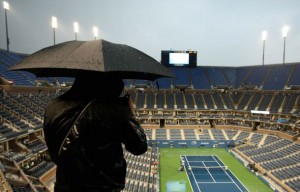By Thomas Swick
swickt@bellsouth.net
The other day I visited the players’ realm of Arthur Ashe stadium and got an idea of how they kill time when they’re not killing tennis balls.
I walked across the red carpet leading to the players’ entrance and through an open gate into the players’ garden. Adirondack chairs, painted bright colors, lined the walkway, and the grass triangle was dotted was umbrellas and wooden lawn furniture. A bar occupied one corner – serving coffee and juices, I found on inspection – and a ping pong table stood in another.

I entered the lobby of what looked like an upscale YMCA. To the left was a room where rackets were being strung by young men whose black T-shirts gave them the appearance of waiters. Stringing waiters. Words strung high across the wall in front of me read:
I wanna waked up in the city that doesn’t sleep to find I’m king of the hill, top of the heap. If I can make it here, I’d make it anywhere. – Theme from New York, New York.
It reminded me of the words from Kipling’s If that are written above the players’ entrance to Centre Court at Wimbledon:
If you can meet with triumph and defeat/And treat those two imposters just the same.
The latter speaks of humility and perspective, the former of ambition and vanity. Grand Slams as indicators of national character.
I climbed the steps to the players’ lounge, which was like an enormous living room, or rather a half dozen living rooms rolled into one. There were chairs and tables and couches, most arrayed around a flat screen TV. There was not a seat without a view of a screen, and there was not a screen without a view of tennis. The one not showing CBS’s coverage of the Open was tuned the Tennis Channel’s replay of the tournament in Dubai. It would still have been a sad sight for the commentators, as all of the TVs were on mute.
I headed down a corridor with windows looking out onto a parking lot, and entered the players’ dining room. It was more grandiose than ours, but the menu looked to be similar – sandwiches, salads, burgers, pastas – if more extensive. Gilles Simon was just finishing his lunch, and I wondered if it’s harder for French players to give up alcohol.
Back in the lounge, I plopped down in a chair. A woman walked through with two small children, appearing as harried as any young mother. (Quite possibly more so.) Andrea Petkovic’s father looked as if he’d just played a five-setter, and eventually stretched out on the couch. People sat talking or texting; two played fussball. One woman – a non-player (and a non-Petkovic) – was reading a book. (Water for Elephants, in Portuguese.)
Numerous languages melded, though Slavic ones predominated, a situation unthinkable in the old Anglo-Hispanic world of Rosewall, Gonzales, Laver and Segura.
A magazine rack hung on the wall near the information desk. Of the ten slots, one was occupied by Inside Tennis, one by More, one by Fitness; the rest held copies of Better Homes or Traditional Home – two magazines that are probably as alluring to touring tennis pros as travel magazines are to the rest of the population.
Downstairs in the lobby, Andy Murray sat on a bench eating fusilli in tomato sauce, while in the string shop, Gilles Muller was racing a young woman to see who was faster at putting a grip on a racket. Out in the garden, Vera Zvonareva was kneeling on a towel and having her arms stretched by a trainer, two young men were competing at ping pong, Caroline Wozniacki’s parents were sitting quietly under an umbrella, and a camera crew was interviewing Oracene Price, mother of the Williams sisters. Feeling a little left out, I headed back to the scribes.
